Enterprise Legacy
Created by Commodore Wilkan Targaryen on Thu Jan 4th, 2024 @ 1:35am
Sea-going Earth Vessels
H.M.S. Enterprise |
|
|---|---|
| Affiliation: | France United Kingdom |
| Class: | 24-gun sixth rate |
| Service Period: | 1705-1707 |
| Complement: | 115 officers and enlisted |
| Fate: | Wrecked |
L'Entreprise / H.M.S. Enterprise
H.M.S. Enterprise (sometimes spelled Enterprize) was launched by the French Navy as L'Entreprise and was captured by H.M.S. Triton in 1705. Registered and commissioned as a Royal Navy ship the same year, she served in the Mediterranean and with Admiral Byng's squadron at the Downs, Enterprise was lost with all hands in 1707.
| Affiliation: | United Kingdom |
| Class: | 44-gun fifth rate |
| Service Period: | 1709-1749 |
| Complement: | 115 officers and enlisted |
| Fate: | Sold |
H.M.S. Enterprise
H.M.S. Enterprise was a 44-gun fifth rate launched in 1709. She underwent a great repair in 1718–19, was hulked in 1740 and fitted as a hospital ship in 1745 before being sold in 1749.
| Affiliation: | Spain United Kingdom |
| Class: | Ex-Barca-longa Sloop |
| Service Period: | 1743-1749 |
| Complement: | 60 officers and enlisted |
| Fate: | Sold |
H.M.S. Enterprize
H.M.S. Enterprize, was a barca-longa captured from the Spanish in 1743 and re-rated as a sloop by the Royal Navy. She spent her entire career in the Mediterranean and was present at the Battle of Toulon in 1744. She would remain in service two additional years until being put up for sale in at Port Mahon, Menorca in the summer of 1748.
| Affiliation: | United Kingdom |
| Class: | 50-gun fourth rate |
| Service Period: | 1744-1771 |
| Complement: | 115 officers and enlisted |
| Fate: | Decommissioned |
H.M.S. Enterprise
Launched as the H.M.S. Norwich in 1693, the vessel was rebuilt according to the 1706 Establishment at Chatham Dockyard and relaunched in 1744 as the H.M.S. Enterprise.Enterprise patrolled the Caribbean until the end of the War of the Spanish Succession in 1748, entering the mothball fleet before being recommissioned in 1756 at the outbreak of the Seven Years' War. Assigned to Atlantic convoy escort, Enterprise was present at the siege and capture of Havana, Cuba and would be decommissioned in January 1764.
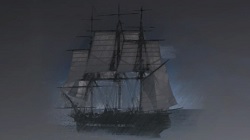 | |
| Affiliation: | United Kingdom |
| Class: | Enterprise |
| Service Period: | 1774-1807 |
| Complement: | 200 officers and enlisted |
| Fate: | Broken Up |
H.M.S. Enterprise
The first ship of her class, the H.M.S. Enterprise was a 28-gun sixth-rate Enterprise Class frigate of the Royal Navy.Enterprise was built at Deptford Royal Dockyard, England and commissioned in 1775. Enterprise served throughout the American Revolutionary War as cruiser and convoy escort before being assigned to service in the Mediterranean. Enterprise was decommissioned in May 1784, but would not be broken up until 1807.
U.S.S. Enterprise |
|
|---|---|
| Affiliation: | United Kingdom United States of America |
| Class: | Sloop-of-war |
| Service Period: | 1775-1777 |
| Complement: | 50 officers and enlisted |
| Fate: | Destroyed |
H.M.S. Enterprize / U.S.S. Enterprise
Launched by the United Kingdom in 1775, H.M.S. Enterprize was a 10-gun tender captured by the Americans in 1775. Rechristened as the U.S.S. Enterprise by the Continental Army, Enterprise was a sloop-of-war that served in Lake Champlain during the American Revolutionary War. She was the first of a long and prestigious line of ships of the United States or by the combatant forces of the U.S. Revolutionary War to bear the name Enterprise.
| Affiliation: | United States of America |
| Class: | Schooner |
| Service Period: | 1776-1777 |
| Complement: | 60 officers and enlisted |
| Fate: | Decommissioned |
Enterprise
Enterprise was the second American ship to bear the name and was a successful privateer before she was purchased for the Continental Navy in 1776. Enterprise operated principally in Chesapeake Bay where she convoyed transports, carried out reconnaissance, and guarded the shores against foraging raids by the British.
 | |
| Affiliation: | United States of America |
| Class: | Schooner |
| Service Period: | 1799-1823 |
| Complement: | 70 officers and enlisted |
| Fate: | Destroyed |
U.S.S. Enterprise
The U.S.S. Enterprise was a schooner built in 1799 that was overhauled and rebuilt several times during her career, effectively changing from a twelve-gun schooner to a fourteen-gun topsail schooner and eventually to a brig. Enterprise saw action in the Caribbean, the Mediterranean, and the Caribbean again, capturing numerous prizes before being destroyed in July 1823.
| Affiliation: | United Kingdom |
| Class: | Enterprise |
| Service Period: | 1806-1816 |
| Complement: | 200 officers and enlisted |
| Fate: | Sold |
H.M.S. Enterprise
Launched as the H.M.S. Resource, the vessel was rechristened Enterprise in 1806 and assigned to service at the Tower of London.
| Affiliation: | United Kingdom |
| Class: | Wooden Paddle Gunvessel |
| Service Period: | 1824-1830 |
| Complement: | 50 officers and enlisted |
| Fate: | Decommissioned |
H.M.S. Enterprise
HMS Enterprise (1824) was a wooden paddle gunvessel purchased in 1824 and in service until 1830.
| Affiliation: | United States of America |
| Class: | Schooner |
| Service Period: | 1831-1844 |
| Complement: | 72 officers and enlisted |
| Fate: | Sold |
U.S.S. Enterprise
The fourth U.S.S. Enterprise was a United States Navy schooner launched from the New York Navy Yard and commissioned in 1831. Initially assigned to South American, Enterprise would later cruise to the Far East by way of Africa, India and the East Indies in an assignment that would lead her to circumnavigate the globe. After a brief inactivation, Enterprise would return to South America on a four year assignment of protecting commerce in the region. Enterprise would leave the region after an engagement with the Chilean schooner Ancud and would be later decommissioned then sold in 1844.
| Affiliation: | United Kingdom |
| Class: | Arctic Discovery Ship |
| Service Period: | 1848-1903 |
| Complement: | 100 officers and enlisted |
| Fate: | Sold |
H.M.S. Enterprise
H.M.S. Enterprise was an Arctic discovery ship laid down as a merchant vessel and purchased in 1848 before launch to search for Sir John Franklin's lost expedition. She made two Arctic voyages before becoming a coal depot, and was finally sold in 1903. She was the tenth Enterprise (or Enterprize) to serve in the Royal Navy.
| Affiliation: | United Kingdom |
| Class: | Ironclad Sloop |
| Service Period: | 1864-1885 |
| Complement: | 130 officers and enlisted |
| Fate: | Scrapped |
H.M.S. Enterprise
The seventh H.M.S. Enterprise of the Royal Navy was an armored sloop launched in 1864 at Deptford Dockyard. Originally laid down as a wooden screw sloop of the Camelion class, she was redesigned by Edward Reed and completed as a central battery ironclad. The ship spent the bulk of her career assigned to the Mediterranean Fleet before returning to England in 1871 where she was paid off. Enterprise was sold for scrap in 1885.
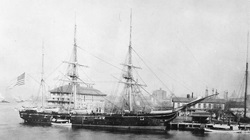 | |
| Affiliation: | United States of America |
| Class: | Screw Sloop |
| Service Period: | 1874-1910 |
| Complement: | 184 officers and enlisted |
| Fate: | Scrapped |
U.S.S. Enterprise
The fifth U.S.S. Enterprise, a barque-rigged screw sloop, was launched from Portsmouth Navy Yard, Kittery, Maine, and commissioned in 1877. Enterprise initially was assigned to surveying responsibilities in the Americas before being reassigned to European waters until 1880. After a brief refit, Enterprise would cruise the east coast of the United States until engaging in a hydrographic survey that led the Enterprise to circumnavigate the world.In 1887 the Enterprise returned to European territory for two years where she showed the flag and looked out for United States' interests. Later, Enterprise operated principally in the Caribbean until being assigned as a training and practice ship at the United States Naval Academy, Annapolis, Maryland. Continuing this tradition, Enterprise was lent to the Commonwealth of Massachusetts for duty as a school ship at the Massachusetts Maritime Academy before being returned to the United States Navy.
| Affiliation: | United States of America |
| Class: | Motorboat |
| Service Period: | 1917-1919 |
| Complement: | 8 personnel |
| Fate: | Decommissioned |
Enterprise SP-790
Enterprise was a private wooden motorboat purchased by the United States Navy for non-commissioned service as a Section Patrol craft during the period of United States participation in World War I.
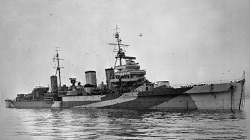 | |
| Affiliation: | United Kingdom |
| Class: | Emerald |
| Service Period: | 1919-1946 |
| Complement: | 572 officers and enlisted |
| Fate: | Scrapped |
H.M.S. Enterprise (D52)
H.M.S. Enterprise was one of two Emerald-class light cruisers built for the Royal Navy and she was the 14th ship to serve with the Royal Navy to carry the name Enterprise.Enterprise served with the 4th Cruiser Squadron in the East Indies for most of her early career and was a distinguished component of the region, but would be assigned to multiple theatres when World War II began and would eventually serve in the Invasion of Normandy.
After helping return British troops from Asia and Africa to the United Kingdom, Enterprise was sent for scrapping.
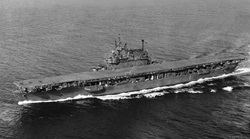 | |
| Affiliation: | United States of America |
| Class: | Yorktown |
| Service Period: | 1936-1947 |
| Complement: | 2,217 officers and enlisted |
| Fate: | Decommissioned |
U.S.S. Enterprise CV-6
U.S.S. Enterprise CV-6 was a Yorktown-class carrier built for the United States Navy during the 1930s and was the seventh U.S. Navy vessel of the name Enterprise. Colloquially called "The Big E", she was the sixth aircraft carrier built by the United States Navy and one of only three American carriers commissioned before World War II to survive the war.Enterprise participated in more major actions of the war against Japan than any other United States ship and included the attack on Pearl Harbor, the Battle of Midway, the Battle of the Eastern Solomons, the Battle of the Santa Cruz Islands, the Guadalcanal Campaign, the Battle of the Philippine Sea, and the Battle of Leyte Gulf. Enterprise earned 20 battle stars, the most for any U.S. warship in World War II, and was the most decorated U.S. ship of World War II. Enterprise also had the nickname "The Grey Ghost" after the Japanese Navy announced that she had been sunk in battle multiple times.
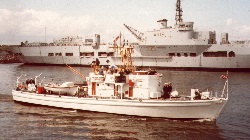 | |
| Affiliation: | United Kingdom |
| Class: | Echo |
| Service Period: | 1959-1985 |
| Complement: | 18 officers and enlisted |
| Fate: | Scrapped |
H.M.S. Enterprise (A71)
The ninth HMS Enterprise (A 71) of the Royal Navy was an Echo-class survey ship commissioned in 1959. Enterprise's career was spent in hydrographic surveys of the seas, sandbanks, and coastlines of the East Coast and Eastern English Channel of the United Kingdom. She was put up for disposal by sale in 1985 and was scrapped in 2023 after sinking in shallow water.
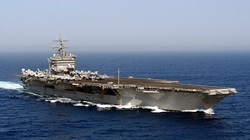 | |
| Affiliation: | United States of America |
| Class: | Enterprise |
| Service Period: | 1961–2012 |
| Complement: | 5,828 officers and enlisted |
| Fate: | Decommissioned |
U.S.S. Enterprise CVN-65
U.S.S. Enterprise CVN-65, formerly CVA(N)-65, was the first nuclear-powered aircraft carrier and the eighth United States naval vessel to bear the name Enterprise. Nicknamed "Big E," like her World War II predecessor, Enterprise was the longest naval vessel ever built and the only ship of her class.Commissioned at Newport News, Virginia in 1961, Enterprise had a distinguished career. During the Cuban Missile Crisis, Enterprise participated in the blockade of Cuba and later was part of a special military operation to circumnavigate the globe without refueling. Later, Enterprise was deployed for service in the Vietnam War, later being deployed mainly in the Pacific and Indian Oceans before being assigned to European waters and later the Persian Gulf. After a refit, Enterprise enforced no-fly zones and later assisted in the war against terrorism before being decommissioned in 2012. At the time of inactivation, the Enterprise was the third-oldest commissioned vessel in the United States Navy.
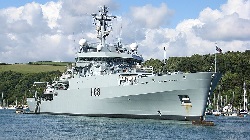 | |
| Affiliation: | United Kingdom |
| Class: | Echo |
| Service Period: | 2003-2023 |
| Complement: | 72 officers and enlisted |
| Fate: | Decommissioned |
H.M.S. Enterprise H88
HMS Enterprise, the tenth ship to bear this name, was a multi-role survey vessel of the Royal Navy. Throughout her career Enterprise undertook exploratory survey missions and humanitarian assignments. She was decommissioned in 2023.
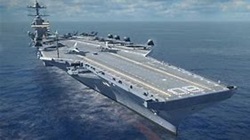 | |
| Affiliation: | United States of America |
| Class: | Gerald R. Ford |
| Service Period: | 2028-2063 |
| Complement: | 4,660 officers and enlisted |
| Fate: | Museum |
U.S.S. Enterprise CVN-80
U.S.S. Enterprise CVN-80 is the ninth United States naval vessel and third aircraft carrier to bear the name Enterprise. The third Gerald R. Ford Class aircraft carrier, Enterprise was commissioned in 2028.Much of Enterprise's history has been lost due to the ravages of World War III; however, it is know that the vessel was involved in several major campaigns during both the Second American Civil War, the Eugenics Wars, and World War III.
Following the conclusion of WWIII, Enterprise was converted into a museum ship in New York City, New York, replacing the Intrepid.
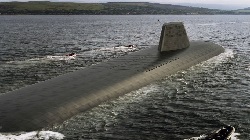 | |
| Affiliation: | United Kingdom |
| Class: | Dreadnought |
| Service Period: | 2032-2039 |
| Complement: | 130 officers and enlisted |
| Fate: | Destroyed |
H.M.S. Enterprise
The eleventh Royal Navy vessel to bear the name, the H.M.S. Enterprise was a Dreadnought Class submarine launched in 2032.Much of Enterprise's history has been lost due to the ravages of World War III; however, it is know that the vessel was involved in several major campaigns during both the Eugenics Wars and World War III. Enterprise was lost during the Third Battle of Barents Sea when the Enterprise rammed an enemy vessel after having lost weapons control.
Early Earth Spacecraft
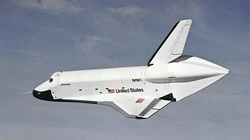 | |
| Affiliation: | United States of America |
| Class: | Space Shuttle Orbiter |
| Service Period: | 1976-1977 |
| Complement: | 8 personnel |
| Fate: | Museum |
Enterprise OV-101
Space Shuttle Enterprise (Orbiter Vehicle Designation: OV-101) was the first orbiter of the Space Shuttle system. Built for NASA as part of the Space Shuttle program to perform atmospheric test flights after being launched from a modified Boeing 747, Enterprise was constructed without engines or a functional heat shield and was not capable of independent spaceflight.Enterprise had been intended to be refitted for orbital flight to become the second space-rated orbiter in service; however, during construction of Space Shuttle Columbia, details of the final design changed making it simpler and less costly to build Challenger around a body frame that had been built as a test article. Enterprise would be considered for refit to replace Challenger after the latter was destroyed, but Endeavour was built from structural spares instead.
Enterprise was restored and placed on display in 2003 at the Smithsonian's new Steven F. Udvar-Hazy Center in Virginia. Following the retirement of the Space Shuttle fleet, Discovery replaced Enterprise at the Udvar-Hazy Center, and Enterprise was transferred to the Intrepid Sea, Air & Space Museum in New York City, where it has been on display since July 2012.
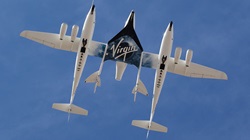 | |
| Affiliation: | Virgin Galactic |
| Class: | SpaceShip Two |
| Service Period: | 2010-2014 |
| Complement: | 3 personnel |
| Fate: | Destroyed |
V.S.S. Enterprise
V.S.S. Enterprise (tail number: N339SS[1]) was the first SpaceShipTwo spaceplane, built by Scaled Composites for Virgin Galactic and was planned to be the first of five commercial suborbital SS2 spacecraft planned by Virgin Galactic. Named in honor of the aircraft carrier Enterprise, V.S.S. Enterprise was also the first ship of the Scaled Composites Model 339 SpaceShipTwo class, based on upscaling the design of record-breaking SpaceShipOne.Enterprise was destroyed during a powered test flight on 31 October 2014, killing one pilot, Michael Alsbury, and seriously injuring another, Peter Siebold. This was the first spacecraft-related accident in which part, but not all, of the crew survived.
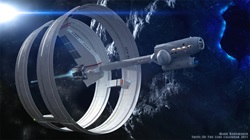 | |
| Affiliation: | United Earth |
| Class: | Declaration |
| Service Period: | 2123-2150 |
| Complement: | 35 officers and enlisted |
| Fate: | Destroyed |
U.S.S. Enterprise (XCV 330)
The U.S.S. Enterprise (XCV-330), previously the UESP Enterprise and also the SS Enterprise, was the first spacecraft named Enterprise to be designated a starship built by United Earth.Originally built as a Starliner, a manned interstellar probe, by the United Earth Space Probe Agency, Enterprise was one of Earth's earliest attempts at interstellar travel. Using Warp technology based on Vulcan design principles, Enterprise's nacelle design proved to be 17% more efficient than Vulcan ships but had trouble operation at high warp speed making it impractical for exploration assignments. Enterprise was also the only one of its class to reach its destination of Alpha Centauri, all the rest were overtaken by recently developed faster-than-light spaceships.
With the completion of the Enterprise NX-01 in 2151, the XCV 330 was rechristened as the Dauntless and remained in service until 2165.
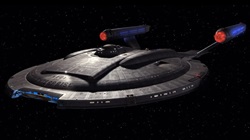 | |
| Affiliation: | United Earth United Federation of Planets |
| Class: | NX |
| Service Period: | 2151-2161 |
| Complement: | 83 officers and enlisted |
| Fate: | Museum |
U.S.S. Enterprise NX-01
The U.S.S. Enterprise NX-01 was an NX class starship in service to United Earth Starfleet in the mid-22nd Century. Launched under the command of Captain Jonathan Archer, Enterprise established United Earth as a legitimate interstellar power and caused a revolution in Alpha and Beta Quadrant politics, leading to the Coalition of Planets and eventually the United Federation of Planets.Early in her career the Enterprise made Earth's first contact with the Klingon Empire, the Tholian Assembly, and the Romulan Star Empire as well as dozens of other races. Concurrently, Enterprise was a player in the Temporal Cold War, actively participating in several skirmishes related to the conflict during its lifetime.
Enterprise's involvement with the Temporal Cold War would come to the a head when the Xindi launched an unprovoked attack on Earth. In response, Enterprise led a mission into the mysterious Delphic Expanse to prevent the Xindi from continuing their campaign against United Earth, leading to a lasting peace between Humans and Xindi. Returning to exploratory missions, the Enterprise was an instrumental part of the founding of the Coalition of Planets, an alliance between the Andorian Empire, Confederacy of Vulcan, United Earth, and the United Planets of Tellar.
Shortly after the foundation of the Coalition, the Romulan Star Empire began hostilities with the nascent alliance, leading to the Earth-Romulan War. Enterprise was refit to Columbia Class standards and was United Earth's Flagship during the war. At the conclusion of the conflict, the Coalition of Planets evolved into the United Federation of Planets. Briefly serving in the new Starfleet, Enterprise was decommissioned in 2161 and placed into the Fleet Museum.
United Federation of Planets
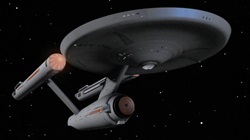 | |
| Affiliation: | United Federation of Planets |
| Class: | Constitution Constitution II |
| Service Period: | 2245-2285 |
| Complement: | 430 officers and enlisted |
| Fate: | Destroyed |
U.S.S. Enterprise NCC-1701
The U.S.S. Enterprise NCC-1701 was a Constitution Class Cruiser launched in 2245 and was one of Starfleet's longest serving ships, undergoing at least five major overhauls and serving in the fleet for forty years. During its tenure, the Enterprise took part in numerous first contacts and military engagements, defending Earth and the entire Federation on several occasions.One of the most famous ships of her time, the Enterprise was commissioned in 2245 under the command of Captain Robert April. In 2254, the Enterprise - commanded by Captain Christopher Pike - traveled to Rigel, Vega, and Talos IV, among other worlds. Her most notable voyage was her five-year exploration mission from 2265 to 2270 while under the command of James T. Kirk. During this time the Enterprise set many records and made various discoveries at one time holding the record for the most first contacts any Federation starship had ever made - a record not broken until the U.S.S. Voyager became stranded in the Delta Quadrant more than 100 years later. The Enterprise also was the second ship to leave the galaxy, though it was damaged and had to be extensively repaired in the process.
At the conclusion of Kirk's five-year mission, the Enterprise was selected for an experimental refit and became the first Constitution II Class starship. After her relaunch, Enterprise saved Earth from the threat presented by V'Ger and later undertook a renewed five-year mission of exploration. In 2285, the Enteprise, nearing the end of its life was transferred to Starfleet Academy as a training vessel, but would become embroiled in a plot by Khan Noonien Singh to seize control of the Genesis Torpedo. Soon afterward, Enterprise was destroyed over the planet Genesis when Kirk activated the self-destruct to destroy a Klingon boarding party.
In honor of the ship and its crews, multiple Starfleet vessels have been named in honor of this Starship Enterprise, all of them bearing the same name and registry.
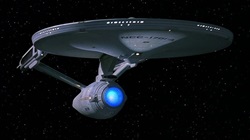 | |
| Affiliation: | United Federation of Planets |
| Class: | Constitution II |
| Service Period: | 2286-2293 |
| Complement: | 300 officers and enlisted |
| Fate: | Museum |
U.S.S. Enterprise NCC-1701-A
The U.S.S. Enterprise NCC-1701-A was a Constitution II Class Cruiser launched in 2286 to replace the U.S.S. Enterprise, which had been destroyed three months earlier at the Genesis Planet. It was under the command of Captain James T. Kirk.Serving in Starfleet for seven years, the Enterprise-A participated in a number of missions during a five-year mission of exploration, including a journey to the Galactic Core. Perhaps the most important mission undertaken by the Enterprise was to support the Khitomer Conference in 2293. After the assassination of Klingon Chancellor Gorkon while under escort by the Enterprise, the crew was able to uncover a conspiracy within the United Federation of Planets, the Klingon Empire, and the Romulan Star Empire to derail the peace process. Heavily damaged during the conflict, Enterprise was decommissioned the same year.
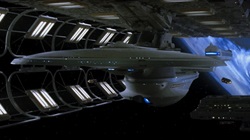 | |
| Affiliation: | United Federation of Planets |
| Class: | Excelsior |
| Service Period: | 2293-2229 |
| Complement: | 750 officers and enlisted |
| Fate: | Lost |
U.S.S. Enterprise NCC-1701-B
The U.S.S. Enterprise NCC-1701-B was a retrofit Excelsior-class Cruiser launched in 2293 under Captain John Harriman to replace the U.S.S. Enterprise-A, which had been decommissioned several months earlier. During her maiden voyage, the Enterprise diverted to respond to a distress call from two El-Aurian refugee transports caught in a temporal energy ribbon. Enterprise rescued 47 survivors, but James T. Kirk was lost and presumed killed.The Enterprise later served as flagship of the Federation, becoming a key figure in exploring beyond the Gourami sector, mapping over 142 star systems and making first contact with 17 different civilizations during its lifetime. Captain John Harriman remained in command of Enterprise until 2311, when the ship played a key role during the Tomed Incident. Following the incident, Harriman stepped down and command was given to his first officer, Demora Sulu.
The ship's last commander was Captain Thomas Johnson Jr., who took command in the early 2320s and was assigned to the Cardassian border. Enterprise rendered assistance to Bajoran refugees when Cardassia annexed Bajor, but was lost in deep space shortly thereafter.
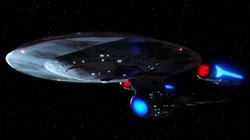 | |
| Affiliation: | United Federation of Planets |
| Class: | Ambassador |
| Service Period: | 2332-2344 |
| Complement: | 700 officers and enlisted |
| Fate: | Destroyed |
U.S.S. Enterprise NCC-1701-C
The U.S.S. Enterprise NCC-1701-C was an Ambassador Class Cruiser, in service to Starfleet, commanded by Captain Rachel Garrett.Launched in 2332 from Earth Station McKinley, Enterprise was primarily oriented toward diplomatic and exploratory assignments in deep space. Initially assigned to the Klingon border, Enterprise worked to maintain the peace between the Federation and the Klingon Empires, but was later transferred to the Alpha Quadrant where the ship was assigned to the Cardassian border.
In 2344, Enterprise defended a Klingon colony in the Narendra System from four Romulan warbirds. Though she destroyed one warbird, she failed to save the colony and was herself destroyed in the conflict. Enterprise's actions impressed the Klingons and led to renewed relations between the Klingon Empire and the Federation.
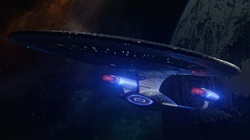 | |
| Affiliation: | United Federation of Planets |
| Class: | Galaxy |
| Service Period: | 2364-2371 2401 |
| Complement: | 1,012 officers and enlisted |
| Fate: | Musuem |
U.S.S. Enterprise NCC-1701-D
The Enterprise, launched in 2364 under the command of Captain Jean-Luc Picard, is one of the most historic vessels within the history of the United Federation of Planets.During its voyages, the Enterprise made numerous additional first contacts, among them with the Devidians, the Ferengi and the Solanae. During its maiden voyage the ship made first contact with the omnipotent Q. In 2365 Q officially introduced the Federation to the Borg collective and the Enterprise was subsequently involved in the events which led to the Battle of Wolf 359 in 2366. The ship also contributed to scientific and archeological discoveries, most notably perhaps the uncovering of an ancient Gateway on Iconia.
The Enterprise was destroyed in 2371, when the ship engaged the Duras Sisters over Veridan III. A few months later, in accordance with the Prime Directive, the saucer section was recovered from Veridan III and moved to the Fleet Museum. Its successor, the Sovereign class U.S.S. Enterprise-E, was launched the following year.
In 2401, during the Frontier Day Invasion, the Enterprise-D - having been reconstructed using its original saucer and components salvaged from the Starship Syracuse - was reactivated by its former command crew to be used to combat the Borg Collective. The Enterprise was able to engage the Borg at the Battle of Jupiter, destroying the last remaining Borg Cube, releasing the conscripted Borg Drones, and killing the Borg Queen in the process. Enterprise herself would later be displayed at the Fleet Museum.
 | |
| Affiliation: | United Federation of Planets |
| Class: | Sovereign |
| Service Period: | 2371-2386 |
| Complement: | 855 officers and enlisted |
| Fate: | Destroyed |
U.S.S. Enterprise NCC-1701-E
The U.S.S. Enterprise NCC-1701-E was a Sovereign Class vessel which served as flagship of the Federation. Placed under the command of Captain Jean-Luc Picard, the Enterprise was initially to be named the Honorious but was renamed in honor of the Enterprise-D, which had been recently destroyed at Veridian III.Initially assigned to the Romulan Neutral Zone, Enterprise would be an instrumental combatant in the Second Borg Invasion of Earth and would later be heavily involved in diplomatic missions during the Dominion War. After helping to repel the Breen Invasion of Earth, Enterprise would uncover a Starfleet conspiracy involving the Briar Patch. Later, Enterprise renewed and deepened diplomatic relations between the United Federation of Planets and the Romulan Star Empire when the Enterprise defeated Praetor Shinzon, but was severely damaged in the battle.
Shortly after its refit and relaunch, Captain Picard was promoted and transferred to the Romulan Relocation Effort after it was discovered that the Romulan star system was at risk of destruction. Worf was promoted to Captain and placed in command in 2381. During this time the Enterprise was primarily an exploratory vessel but was involved in several high-profile assignments including the capture of the U.S.S. Protostar, in which the vessel was severely damaged. Later, Enterprise was involved in an incident at Kriilar Prime, which resulted in Captain Worf leaving the vessel. Enterprise was later involved in a classified mission and was no longer in service by 2386.
 | |
| Affiliation: | United Federation of Planets |
| Class: | Odyssey |
| Service Period: | 2386-2401 |
| Complement: | 1,600 officers and enlisted |
| Fate: | Decommissioned |
U.S.S. Enterprise NCC-1701-F
The U.S.S. Enterprise NCC-1701-F is an Odyssey Class starship that was launched in 2386 and had been commanded by several captains during her years of service.First commanded by Captain Dazad Teagarden, the Enterprise was assigned to the Romulan Neutral Zone following the termination of the Romulan Relocation Effort and was one of the first vessels to render aid after the collapse of the Romulan star in 2387. Operating out of former Romulan territory, Enterprise made contact with several conscripted races that had been in service to the Romulan Empire before being reassigned to the Alpha Quadrant under a new Captain. Enterprise would later lead a series of deep space exploratory assignments before being assigned to rescue Raillian refugees on Fenton IV. During this mission, Enterprise's critical systems were severely compromised in an operation now known as the Monfette Gambit. As a consequence, Enterprise was scheduled to be decommissioned at the 250th Frontier Day.
Placed under the command of Admiral Elizabeth Shelby, the Enterprise and her crew were partially assimilated by the Borg. Enterprise would serve as the flagship of the conscripted Borg armada, leading the attack on Sol Station and coordinating the later attack on Earth. Enterprise was stopped by the crew of her predecessor, the Enterprise-D, when that vessel defeated the Borg Cube at Jupiter. Released from their assimilation, Enterprise was decommissioned.
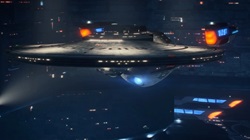 | |
| Affiliation: | United Federation of Planets |
| Class: | Constitution III |
| Service Period: | 2402-2435 |
| Complement: | 500 officers and enlisted |
| Fate: | Destroyed |
U.S.S. Enterprise NCC-1701-G
The U.S.S. Enterprise NCC-1701-G was a Federation Constitution III Class cruiser.Originally christened as the U.S.S. Titan NCC-80102-A in 2396 under the command of Captain Liam Shaw, the Titan-A was instrumental in the defense of the Federation during the Frontier Day Invasion, leading efforts to stop the combined Borg and Changeling threat. Because of the heroism of the command crew of the USS Enterprise-D, and the crucial part the ship had played in assisting their efforts to counter the Borg, the Titan-A was rechristened as the Enterprise-G and placed under the command of Captain Seven of Nine. Assigned to deep space exploratory assignments, the Enterprise was sent to survey deep space beyond former Romulan territory in the Beta Quadrant.
During its sixth five-year mission, command of the Enterprise was transferred to Captain Willian Teagarden following the retirement of Captain Seven of Nine in 2430. Enterprise's existing five-year mission was cancelled and the vessel recalled to Earth. Assigned to the Diplomatic Corps, Enterprise primarily served as a diplomatic vessel and transported members of the Federation Council and the Federation President on assignments. Later, Enterprise would find itself embroiled in several high-profile incidents including the Vaadwaur Invasion, ultimately leading to the Enterprise's destruction in the Battle of the Foundry.
Categories: No categories found